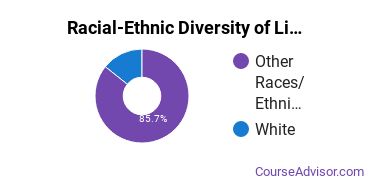Liberal Arts General Studies at White Earth Tribal and Community College
WETCC is located in Mahnomen, Minnesota and approximately 141 students attend the school each year.
Want to know more about the career opportunities in this field? Check out the Careers in Liberal Arts General Studies section at the bottom of this page.
WETCC Liberal Arts General Studies Degrees Available
- Associate’s Degree in Liberal Arts
WETCC Liberal Arts General Studies Rankings
Find White Earth Tribal and Community College Programs
Maximize your transfer credits and complete your bachelor's degree faster with this flexible online bachelor's from Southern New Hampshire University.
Liberal Arts Student Demographics at WETCC
Take a look at the following statistics related to the make-up of the liberal arts majors at White Earth Tribal and Community College.
WETCC Liberal Arts General Studies Associate’s Program

WETCC does a better job with serving racial-ethnic minorities than the typical school does. Its associate's program in liberal arts graduates 50% more racial-ethnic minorities than the nationwide average.*
The following table and chart show the race/ethnicity for students who recently graduated from White Earth Tribal and Community College with a associate's in liberal arts.

| Race/Ethnicity | Number of Students |
|---|---|
| Asian | 0 |
| Black or African American | 0 |
| Hispanic or Latino | 0 |
| White | 0 |
| International Students | 0 |
| Other Races/Ethnicities | 21 |
Concentrations Within Liberal Arts General Studies
If you plan to be a liberal arts major, you may want to focus your studies on one of the following concentrations. The table shows all degrees awarded in this field awarded for all degree levels at White Earth Tribal and Community College. A concentration may not be available for your level.
| Concentration | Annual Degrees Awarded |
|---|---|
| Individualized Studies | 21 |
Careers That Liberal Arts Grads May Go Into
A degree in liberal arts can lead to the following careers. Since job numbers and average salaries can vary by geographic location, we have only included the numbers for MN, the home state for White Earth Tribal and Community College.
| Occupation | Jobs in MN | Average Salary in MN |
|---|---|---|
| Professors | 630 | $64,840 |
References
*The racial-ethnic minorities count is calculated by taking the total number of students and subtracting white students, international students, and students whose race/ethnicity was unknown. This number is then divided by the total number of students at the school to obtain the racial-ethnic minorities percentage.
More about our data sources and methodologies.

